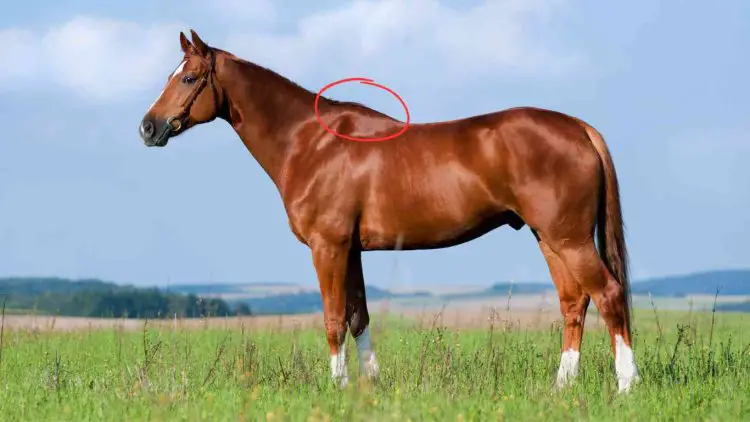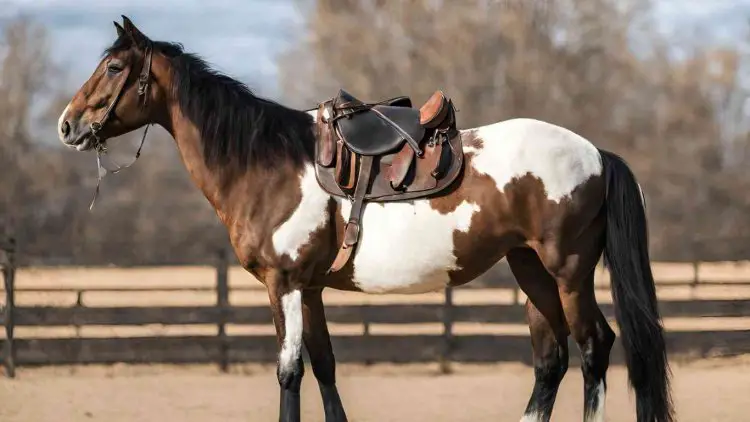Withers on a Horse: Anatomy, Function, Problems & Care
The withers on a horse are a vital yet overlooked part of a horse's anatomy. Located between the shoulder blades, these are the highest points on a horse's back. Understanding the withers helps ensure proper saddle fit, healthy muscle attachment, and overall well-being. Issues like sores, injuries, and asymmetry may arise. Prevent problems through grooming, saddle-fitting, exercises, and veterinary care. Healthy withers allow freedom of movement and indicate good condition. Caring for your horse's withers is essential for their comfort and performance. This post offers an engaging ride through the anatomy of the withers and underlines its role in equine health. Discover potential problems linked to the withers, from saddle sores to injuries, and learn how to prevent or manage them for your horse's comfort and health. The knowledge you gain from our comprehensive guide on horse withers can transform your riding experience and take your horse's well-being to the next level.

Table of Contents
Introduction
Hey there, horse enthusiast! Time to gallop into the world of horses and understand a vital yet often overlooked aspect - the 'withers.' You may have come across the term, but let's dive into what these crucial parts of horse anatomy really are. Picture this - the ridge on a horse's back, sitting right between their shoulder blades, that's the highest point. That's the withers. It's a kind of junction connecting the neck and body. Measuring a horse's height happens from the ground up to the withers, with each 'hand' of height being equivalent to four inches. As a horse aficionado, riding skills aside, understanding the withers can give you the superpower to look after your horse's health and enhance its performance.
Alright, here's where things get juicy. We're not just about decoding the withers; we want to hand you the full guidebook. We'll be exploring the anatomy and function of the withers, understand their importance in your horse's health and wellness, uncover issues and solutions tied to the withers, recommend appropriate exercises, and point you in the direction of handy resources for horse care.
Anatomy of the Withers
Location of Withers on Horse Body:
Okay, time to put your Horse Anatomy 101 hats on. The withers sit comfortably on a horse's back, right smack between the shoulder blades at the base of the neck. It's easy to spot because it's the tallest point and forms a neat transition from the neck to the body.
Bone Structure of Withers:
Next up, what's beneath the surface? These pronounced withers result from the dorsal spinous processes around the 3rd to 11th thoracic vertebrae. These vertebrae stand taller than the rest of the horse's spine, giving them a distinctive skeletal backbone.
Muscles and Tissues Around Withers:
Horses aren't just about brawn, they're about brains too. The withers are surrounded by a complex network of muscles, ligaments, and soft tissues. Big words like trapezius, rhomboid, serratus, and spinalis might come off as horse jargon, but they're really the withers' best buds lending them support and flexibility for their movements. Grasping the withers' anatomy is like learning their love language - it's essential to taking care of them and ensuring their well-being.
Related: Understanding Roach Back in Horses: Causes & Care
Functions of the Withers in Horses
Support for the Saddle:
So, what do the withers do all day? Well, they have a pretty important job - they are the stage for the saddle to rest, ensuring it stays comfortably in place regardless of whether your horse is trotting, cantering, or galloping. But it's not just about comfort; it's a key ingredient in keeping your horse safe and sound and you steady and secure.
Attachment for Muscles:
Beyond happily supporting the saddle, the withers are the rock onto which several muscles, like the trapezius and serratus, are anchored. It plays a defining role in your horse's range of motion, strength, and agility, particularly in its neck and front limbs.
Importance in Equine Health:
Last but not least, the story that the health of the withers narrates about your horse's overall health is a bestseller. Watch out for signs like swelling, changes from symmetry, or discomfort. Peculiar movements of the withers could wave the red flag for lameness. Remember, the withers are key players in identifying any health issues.
Common Issues with the Withers
Saddle Sores:
So what can go wrong with the withers? Saddle sores top the list. An ill-fitted saddle could cause these painful sores due to friction as the horse moves. Left untreated, they could lead to infection or other complications.
Pressure Points:
Next up, pressure points. The saddle, if badly fitted, might be a pressure point villain causing discomfort on the withers and nearby areas. Over a period of time, this could mean pain or even tissue damage. The hero here is a well-fitted saddle to help distribute weight evenly, saving the day by reducing the risk of these pressure points.
Injuries and Soreness:
Remember the hard-working muscles enveloping the withers? They are prone to getting strained or injured, especially if the horse is involved in intense physical activities. Improper riding techniques or accidents can also lead to soreness or even fractures in severe cases.
Preventing and Managing Withers Problems

Proper Saddle Fit:
So, how can you limit the issues and manage the ones that pop up? Firstly, the saddle - make sure it fits like a glove. A well-fitted saddle curtails friction, wards off the formation of pressure points, and empowers the horse to move freely and comfortably. If you're muddled about the right saddle fit, it might be worth ringing up a professional saddle fitter. They can help make sure your horse's ride is as comfortable as possible.
Regular Grooming and Inspection:
On top of the perfect saddle, keep an eye on your horse's withers through regular grooming and inspection. Spotting changes early on, like signs of sores or swelling, or if your horse flinches while you're handling the withers, can stop minor issues from ballooning into major problems.
Veterinary Care and Treatment:
Despite your best efforts, let's face it, some problems may still trot in. Don't sweat it, your vet can help manage these issues. Treatment could involve anything from pain management to topical solutions, wound treatment, or in more serious cases, surgery. Above all, remember, that your horse's wellness is always a top priority, so don't hesitate to seek professional help if needed.
Exercises and Stretches for Withers Health
Stretching Techniques:
A fit and healthy horse isn't just about good genes. Regular stretches and strengthening exercises are like the whip and spur for the health of its withers. One popular stretch is the carrot stretch, where you encourage the horse to stretch its neck and back following a carrot. But tread carefully - make sure that your horse is warmed up and that the movements are slow and controlled.
Strengthening Exercises:
In addition to stretches, consider some strengthening exercises for your horse. Activities like hill work, controlled backing up, and trotting over poles are all helpful in building strength and resilience around the withers.
FAQs
What do high withers on a horse mean?
Well, when a horse sports high withers, it basically has a narrower chest and back than usual. This unique anatomy can mean it might take you a little more time to find a saddle that fits just right. Jamming an ill-fitted saddle on there could end up putting pressure on those high withers, causing your equine buddy discomfort. But don't let those high withers stress you, they do not diminish your horse's ability to show off its skills!
What are good withers on a horse?
In the world of horses, 'good' withers are typically ones that have a well-defined and well-muscled structure, smoothly blending into the horse's neck and back. An ideal wither sits well behind the point of the horse's shoulders, keeping the top line of the horse's neck about twice as long as the underline. The shoulders then roll forward from the withers at an angle that allows your horse freedom of movement. Saddle fitting is also a breeze with such withers.
Where are the withers on a horse?
Trot over to your horse, and trace your eyes along its back. On that stretch, you'll spot a ridge sitting right between the shoulder blades at the base of its neck. There you have it, that's where the withers call home! They're easy to spot as they're usually the highest point of a horse's body and form a nice little transition from its neck to its body.
What is the purpose of the withers?
The withers on a horse hold an array of responsibilities. They stand tall like a natural throne for the saddle, ensuring it stays in place even when the horse is galloping around at full tilt. But that's not all! They also act as anchor sites for multiple muscles. This makes the withers a rather influential figure in the horse's range of motion, strength, and agility, especially in the neck and front limbs areas. Plus, they can provide clues about the horse's overall health. So, in other words, an unsung hero!
Conclusion
So there you have it - everything about horse withers, the unsung hero of horse anatomy. Nestled between the shoulder blades, the withers support numerous muscles, provide a natural seat for the saddle, and can give you an indication of your horse's health.
Being a horse caretaker doesn't mean just riding and grooming. It also involves understanding their anatomy and maintaining their overall health. Little things like grooming regularly, attending to saddle fit, and looking for signs of discomfort can make a world of difference in your horse's life.
At the end of the day, who doesn't want to see their horse prance about joyfully, glowing with health? Paying attention to the health of your horse's withers can add significantly to their overall well-being. So let's take the reins and apply the knowledge gained from this blog to ensure that our horses are as happy as can be. It's all part of the wonderful journey with horses.
What's Your Reaction?

















